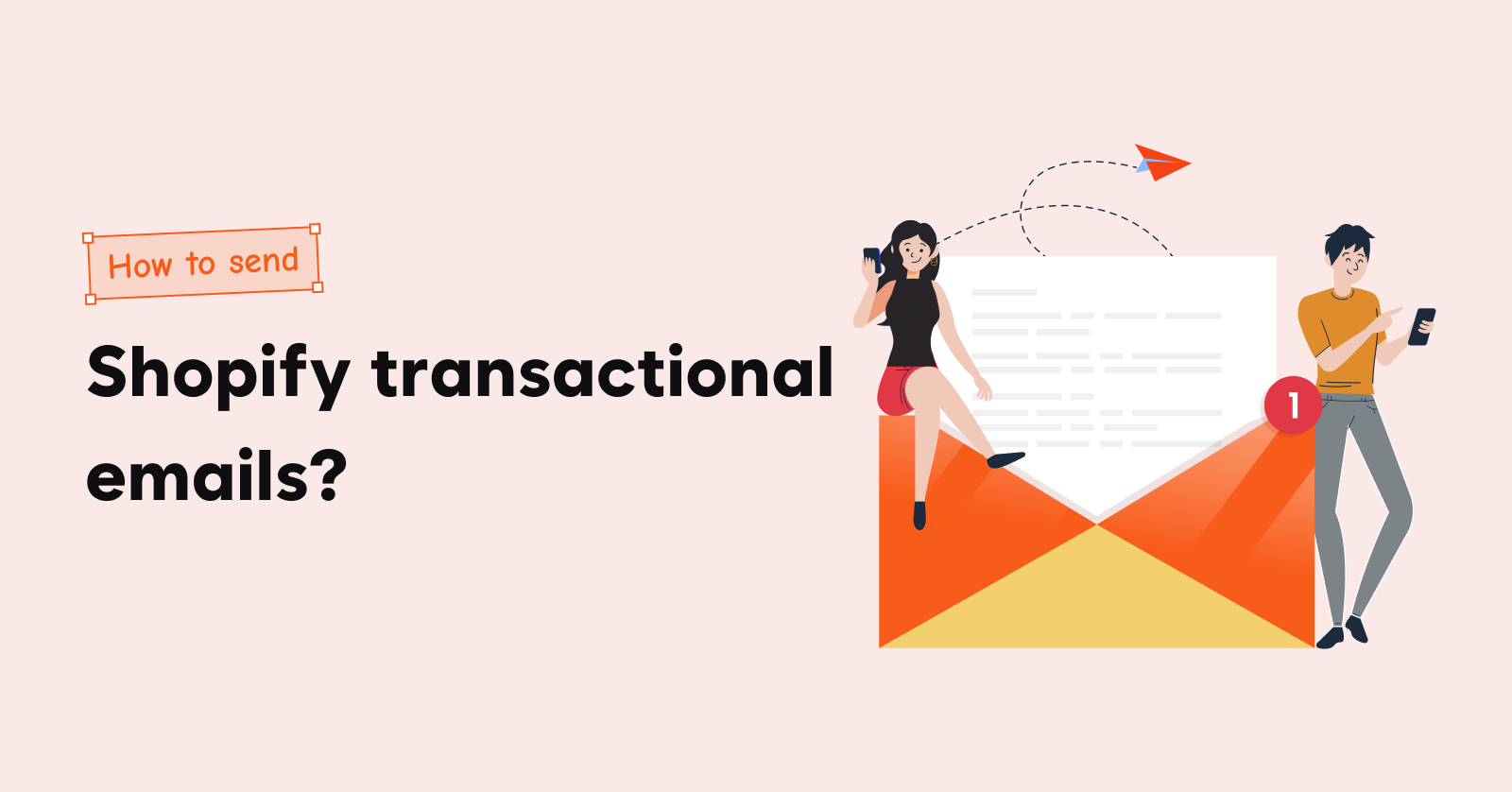Shopify email marketing will yield you more returns than any other marketing channel out there. True now, as it was two decades ago – email has been the OG of the marketing world.
The numbers say so, too. Email marketing gives you an ROI of $40 for every dollar spent.
At its core, it is not about just sending Shopify marketing emails. It entails a strategic approach to building relationships with customers and engaging them throughout their buying journey. Those who nail this email marketing strategy in Shopify succeed.
This blog explains how to use Shopify email marketing with expert tips and how to create high-converting email marketing campaigns.
Let’s dive right in.
Do cost-effective email marketing with Retainful. Recover abandoned carts, drive repeat sales and win-back customers effortlessly.
What is Shopify Email Marketing?
Shopify email marketing is a marketing channel used by e-commerce businesses on the Shopify platform to communicate with customers and promote products through email campaigns.
Email marketing for Shopify involves:
- Building an email list
- Automating emails
- Sending personalized email campaigns
- Tracking campaign performance
The goal of Shopify email marketing is to engage with customers, drive sales, increase brand awareness, and build long-term customer relationships.
To get the most out of your e-commerce email marketing efforts, you can leverage the Shopify platform’s tools and integrations with email marketing platforms to manage and automate the Shopify email campaigns efficiently.
Types of Shopify Email Marketing Campaigns
You can’t send the same type of marketing emails in Shopify throughout the customer’s journey. The stage of the email marketing funnel the customer is in demands a different one.
For instance, you can’t send a referral email to a new customer.
Here are the types of email marketing campaigns you can send:
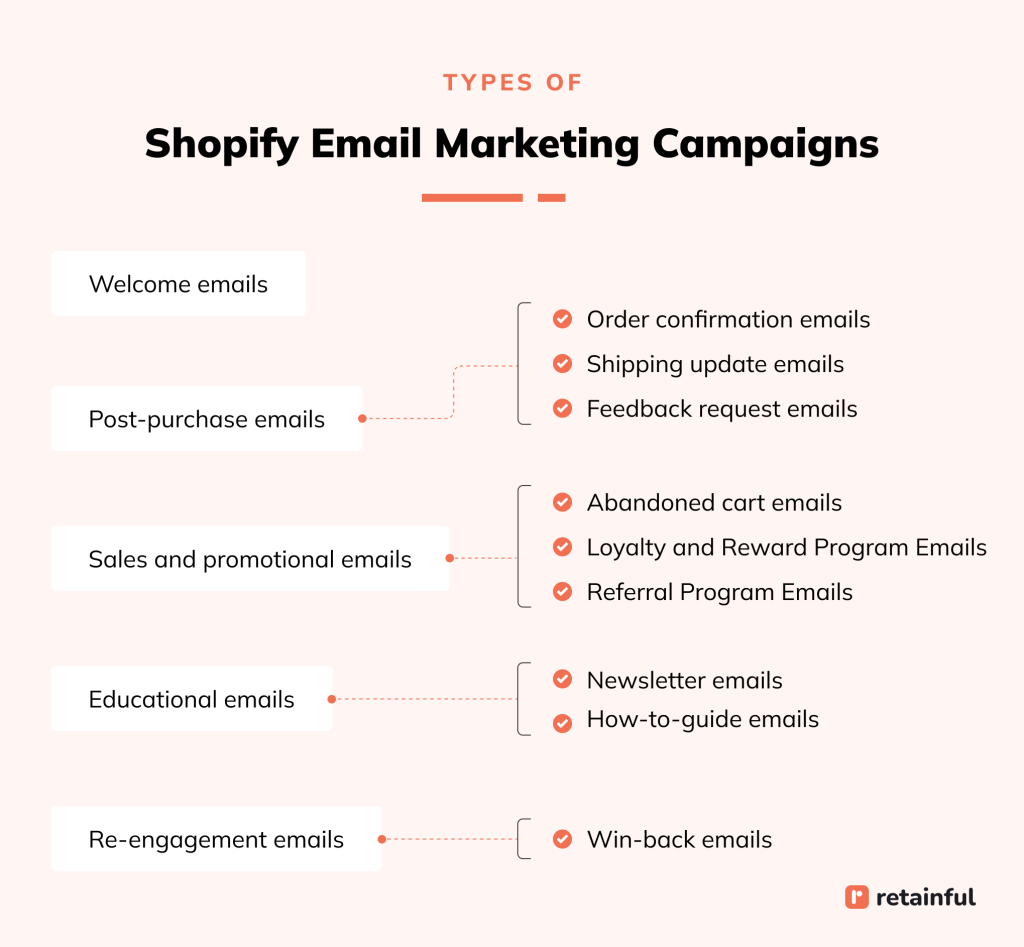
6 High-Converting Shopify Email Campaigns to Send
Two things determine the impact of your email marketing in Shopify: timing and relevancy. These two go hand in hand.
To get it right, you have to know what type of emails to send and when to send it.
Let’s learn both by exploring examples of effective Shopify email campaigns.
1. Welcome emails
Shopify welcome emails are the first interaction you have with your customer – the first impression you create.
Send the welcome emails after a customer makes the first purchase or sign up for your emails.
Most impressively, welcome emails have the highest open rate out of all marketing emails you will send. It implies that customers expect your welcome message and are interested in what you have to say in it.
So, craft an engaging one.
Here is an example of a welcome email template.
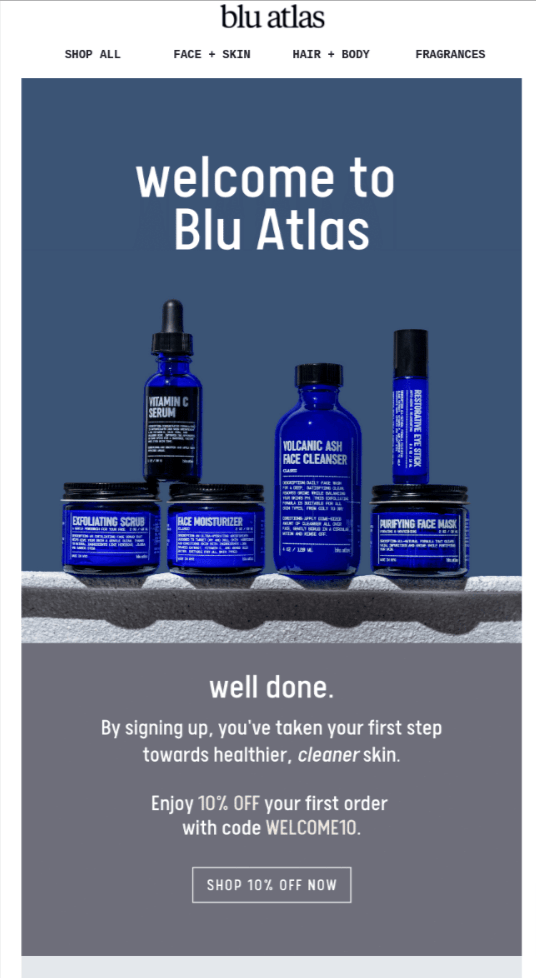
What to include in your Shopify welcome email marketing template:
- A warm, personalized welcome message.
- Brief introduction to your brand, mission, or story.
- Detail the unique benefits of your products.
2. Abandoned cart emails
Shopify abandoned cart emails hold the key to facing every Shopify owner’s nightmare – abandoned carts.
We know it is difficult to move the needle, but –
Shopify abandoned carts are common but not a lost cause. You can recover them by sending Shopify cart reminder emails to the customers and prompt them to finish the purchase.
And, the Shopify abandoned cart emails outperform other cart recovery methods. It boasts an open rate of 30%, and out of them, 11% leads to abandoned cart recovery.
Here is an example of a Shopify email marketing template for abandoned cart emails.
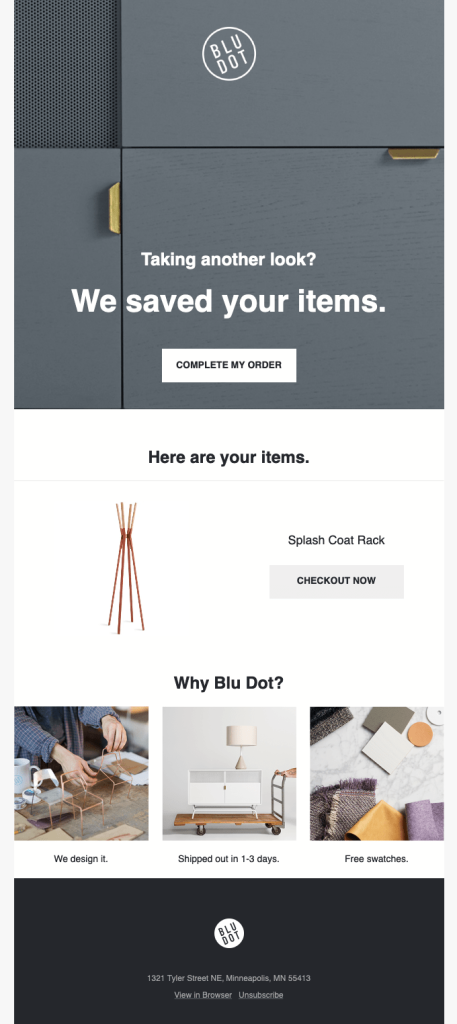
What to include in your Shopify email marketing template for abandoned cart emails:
- Include images of abandoned cart items
- Address customer objections like shipping costs, return policy, and your brand USP.
Recover 10-20% of lost sales by sending abandoned cart emails with Retainful’s easy-to-setup automation.
3. Post-purchase emails
Shopify post-purchase email is any email you send after a customer purchases a product. Its purpose is to nurture and retain customers through constant communication.
Some of the post-purchase emails are transactional in nature – like Shopify order confirmation emails and shipping information emails. Other emails are thank you emails, feedback request emails, educational emails, and cross-sell emails.
Here is an example of a post-purchase Shopify order confirmation email.
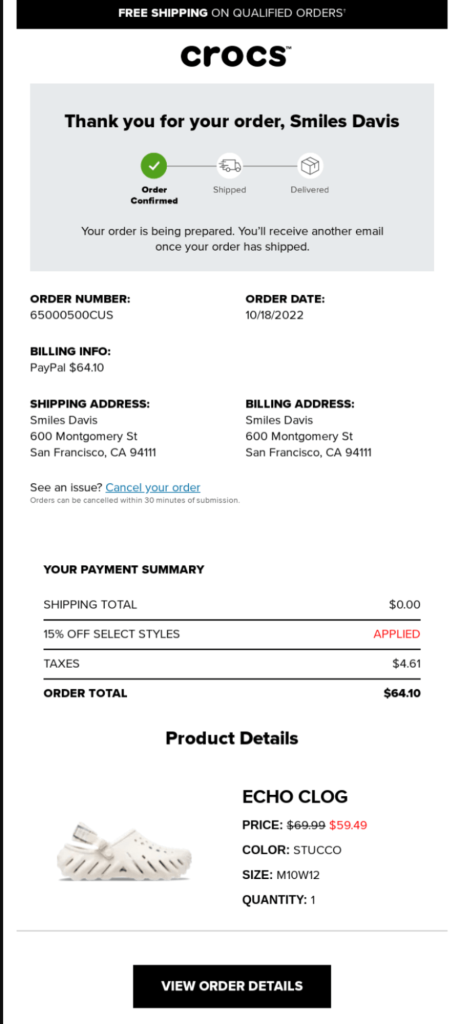
What to include in your post-purchase Shopify email marketing template:
- Include order summary, order tracking link, and expected delivery time
- Include CTA to the order tracking page
4. Promotional emails
Promotional emails are the staple of email marketing. This is where you showcase your new products and discounts, recommend products, and increase brand awareness.
Creating effective Shopify promotional emails will help you position your brand and spread the word about your new offerings.
Here is an example of a Shopify product launch email template.
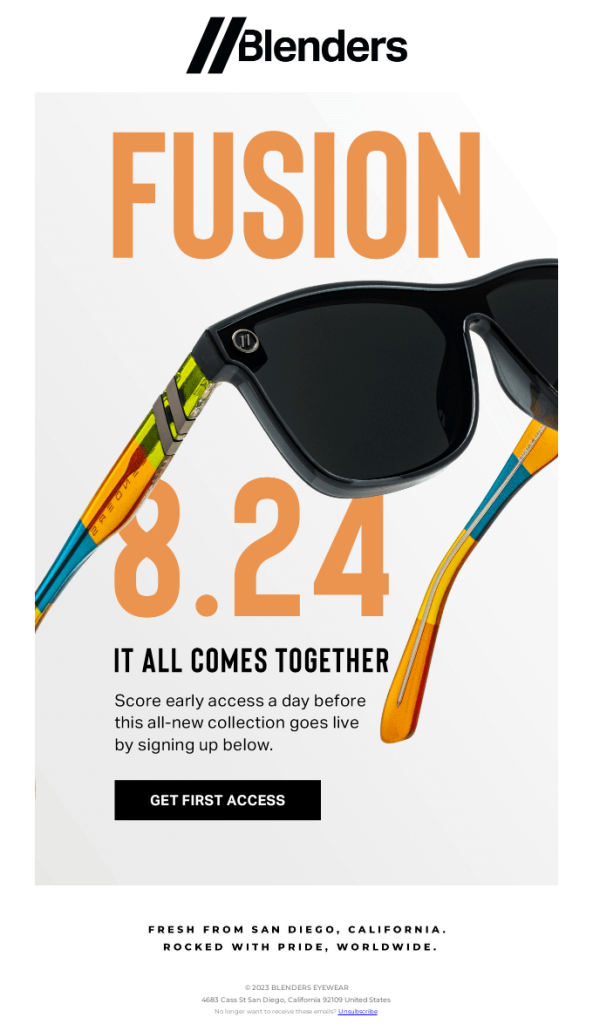
What to include in your product launch Shopify email marketing template:
- Include CTA to the early access of the product.
- Explain what the product is and its key features.
- Highlight what sets your product apart.
5. Referral emails
If you have gained customers who have made repeat purchases, it is time to turn them into your brand advocates and incentivize them to do so through referral emails.
This is the part of lifecycle email marketing where your customers will be forming a real connection with your brand.
Here is an example of a Shopify referral email template.
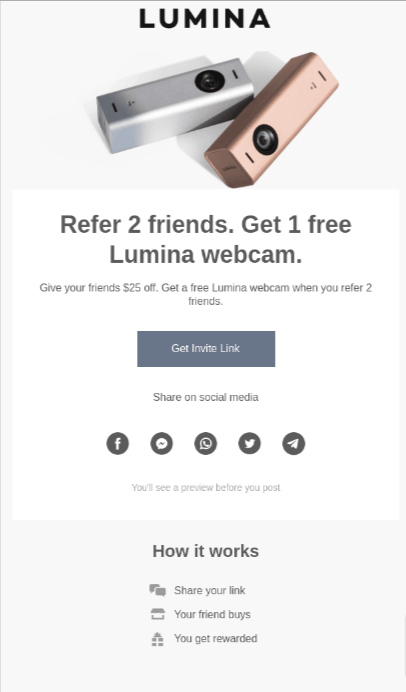
What to include in your referral Shopify email marketing template:
- Highlight what both the referrer and the referee will gain from the referral.
- Provide easy-to-follow steps on how to make a referral.
6. Re-engagement emails
Some customers stay, and some lapse. But you can still get them back into your fold with a Shopify win-back email sent after more than 90 days of inactivity.
Here is an example of a Shopify win-back email template.
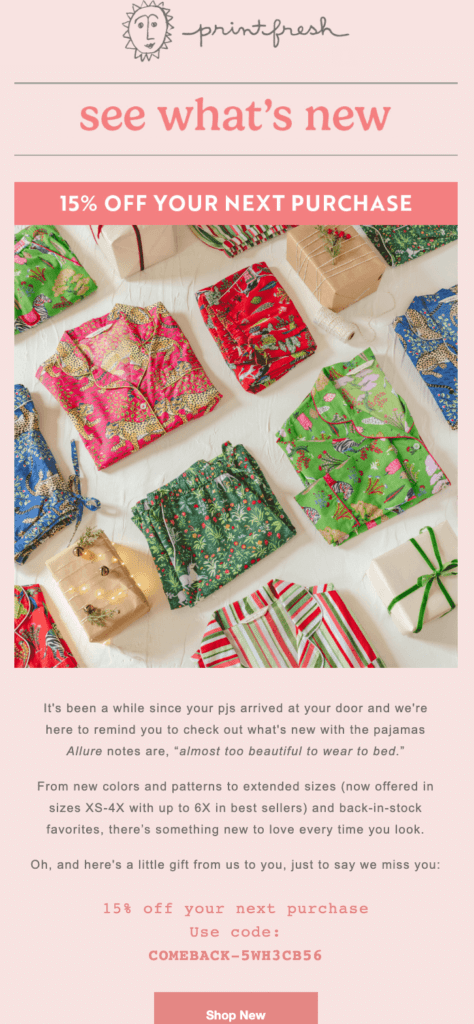
What to include in your win-back Shopify email marketing template:
- Acknowledge the absence of the customer
- Cite recent improvements like new product launches and new offers
- Include a win-back offer
- Included social proof about new products
Related Reading: Want more inspiration to design high-converting templates? Check out our blog:
10 Best Ecommerce Email Examples + Tips
8 Great Re-engagement Email Examples to Reactivate Customers
How to build a Shopify email list?
You can build a Shopify email list by reaching out to potential customers with a compelling reason to join your list and capturing their email addresses.
Here are a few growth strategies for building a Shopify email list.
Offer incentives
Give potential subscribers a compelling reason to join your list. This could be a discount code, a freebie, an exclusive ebook, or early access to sales.
Create opt-in forms
Opt-in forms are tools through which visitors voluntarily provide their email addresses, usually in exchange for something of value (like a discount, information, or access to exclusive content).
These can be popups or sidebar forms. Ensure they are noticeable and easy to fill out.
The best Shopify email marketing strategy is to find strategic places to include your opt-in forms are the homepage, blog sections, during checkout, and at the footer of your site.
Related Reading: Explore the best list-building tools for Shopify in our blog:
The 11 Best Email List Building Tools To Increase Conversions
10 Best Shopify Popup Apps to Grow Your Email List
Create a high-converting landing page.
Create dedicated landing pages for email sign-ups. These pages can be linked from your social media profiles, paid ads, or guest blog posts.
Utilize popups on your store.
Popups show the right content at the right time. When implemented correctly, it can significantly increase email sign-ups for your Shopify email marketing.
Here are some of the ways you can use targeted Shopify popups:
- Welcome popups– Display a popup shortly after a visitor lands on your site.
- Timed popups – Set popups to appear after a visitor has spent a certain amount of time on your site.
- Exit-intent popups – These popups trigger when a user shows signs of leaving the website, such as moving the cursor toward the close button.
- Scroll-triggered popups – These appear after a visitor has scrolled a certain percentage of a page.
Use lead magnets
A lead magnet is essentially an incentive that marketers offer to potential buyers in exchange for their email addresses. They come in various formats, such as ebooks, discount codes, free trials, webinars, whitepapers, or any exclusive content.
How to Create a Shopify Email Marketing Campaign using Shopify Email?
To create a Shopify email marketing campaign, you can use a built-in Shopify Email app or a third-party Shopify email marketing app.
With Shopify Email, you can create, send, and track email marketing campaigns within Shopify.
Steps to create an email marketing campaign using Shopify Email are:
- Install and set up Shopify Email
- Create and import email lists
- Segment your email list
- Choose the Shopify email marketing template
- Customize Shopify email templates
- Test and launch the campaign
Let’s see these steps in detail.
Step 1: Install and set up Shopify Email app
Things you need to set up Shopify email marketing are:
- An active Shopify account and a plan. You can’t send emails without a payment plan in Shopify.
- The Shopify Email app should be installed on your account.
To install Shopify Email, go to Apps -> Search for ‘Shopify Email -> Click Install.
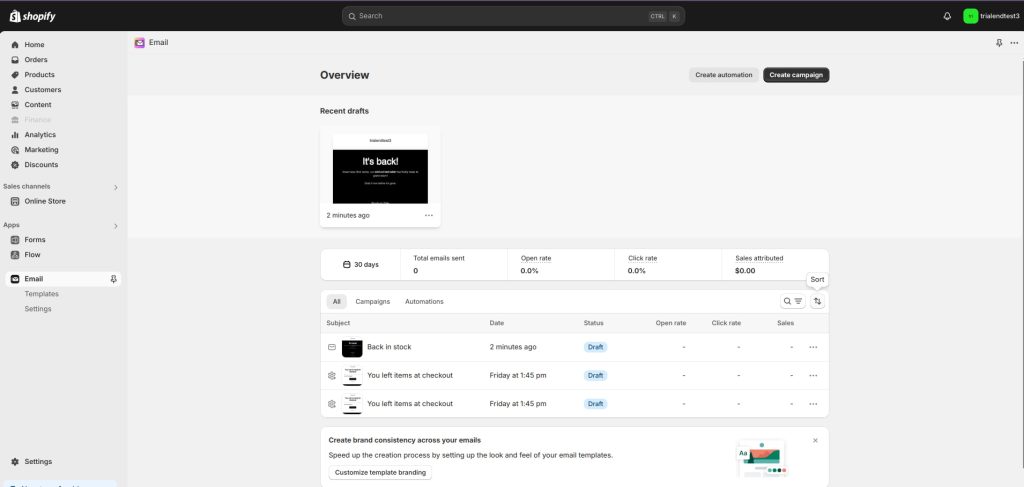
To set up Shopify email marketing, go to Shopify Admin ->’Marketing’. Click on ‘Create Campaign’ -> Shopify Email.
Step 2: Create and import email lists
Importing your email lists is the first step to set up email marketing on Shopify.
To import your email list, log in to your Shopify account and sync your contacts with your Shopify store. In the menu, go to ‘Customers’.
You can import all of your customers by uploading a CSV file, or you can add a customer manually by filling out their details.
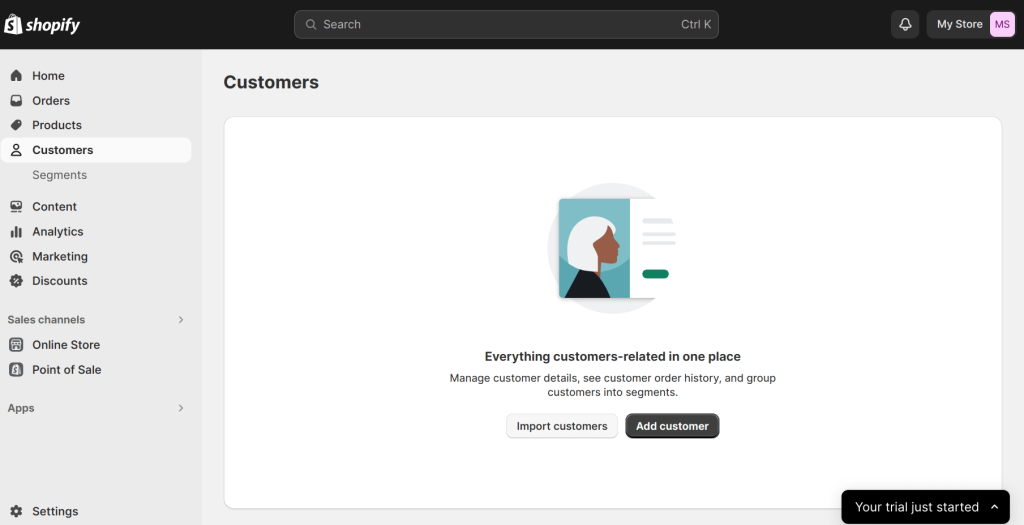
This is how you can implement the Shopify email campaign setup.
Step 3: Segment Shopify email list
The best Shopify email marketing strategy is to segment your customers and target them with relevant Shopify automated emails that resonate with the unique characteristics of those customers in mind.
To create segments, click ‘Segments’ below the Customers option.
You can select the already available segments on Shopify based on the customer data you provided, or you can create your own.
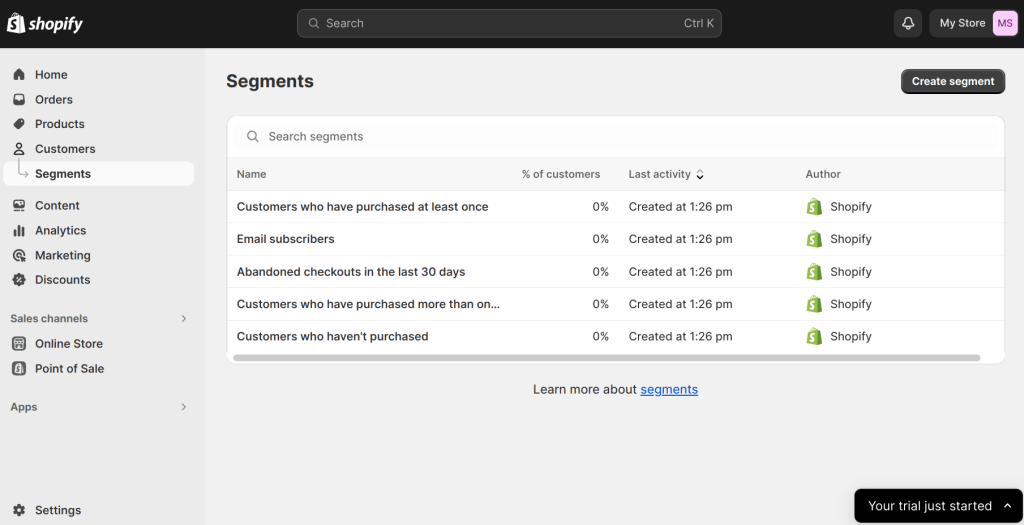
You can create a new segment in two ways – choosing a template or using filters.
By using the template, you can add fields and customize the values based on which you segment your customers.
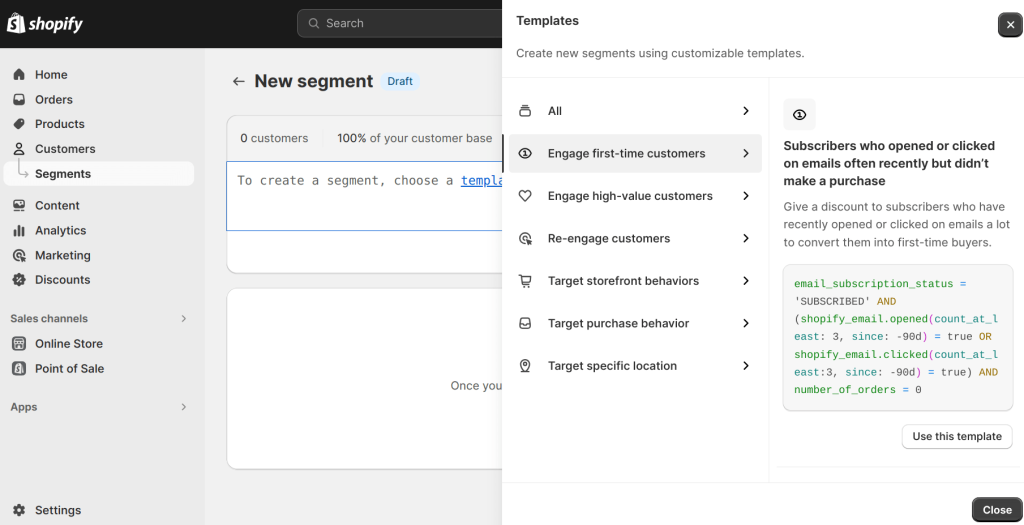
‘’Filters’ are criteria or conditions used to categorize and segment your customer base into more specific groups.
For example, by using filters, you can group the customers to form a segment that has purchased a specific product.
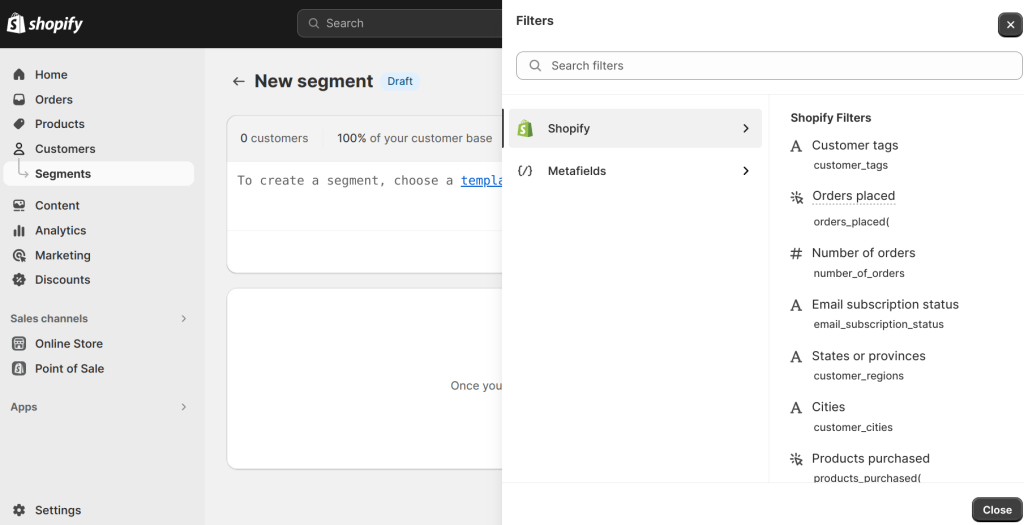
After creating a customer segment, new customers who match the criteria will be automatically included in that customer segment.
Step 4: Choose the Shopify email marketing template
In this step, you can choose a template based on what type of marketing emails you want to send.
To choose the email marketing template in Shopify, go to ‘Marketing’ and click ‘Create campaign.’
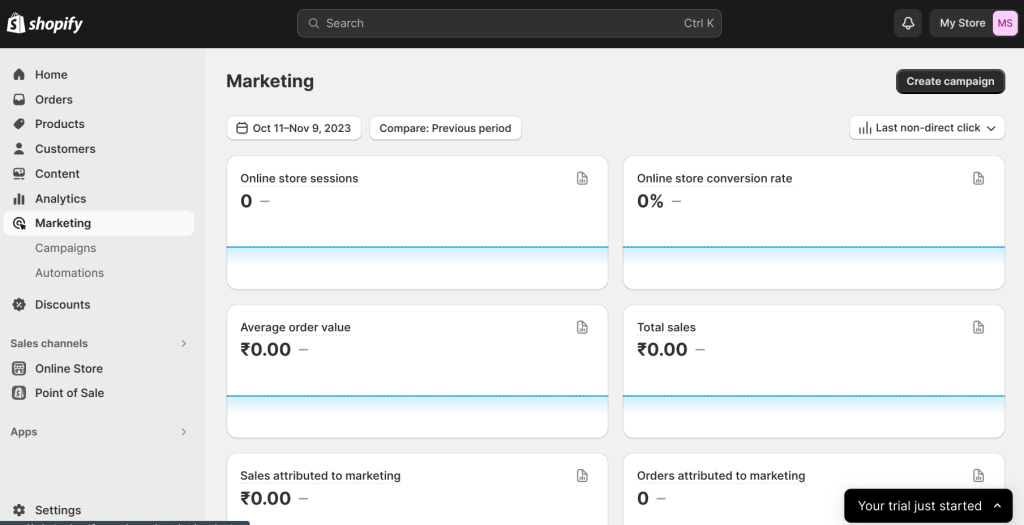
You will be asked to choose the marketing channel. Under Email, you can choose the Shopify Email app or install email marketing software from the Shopify store.
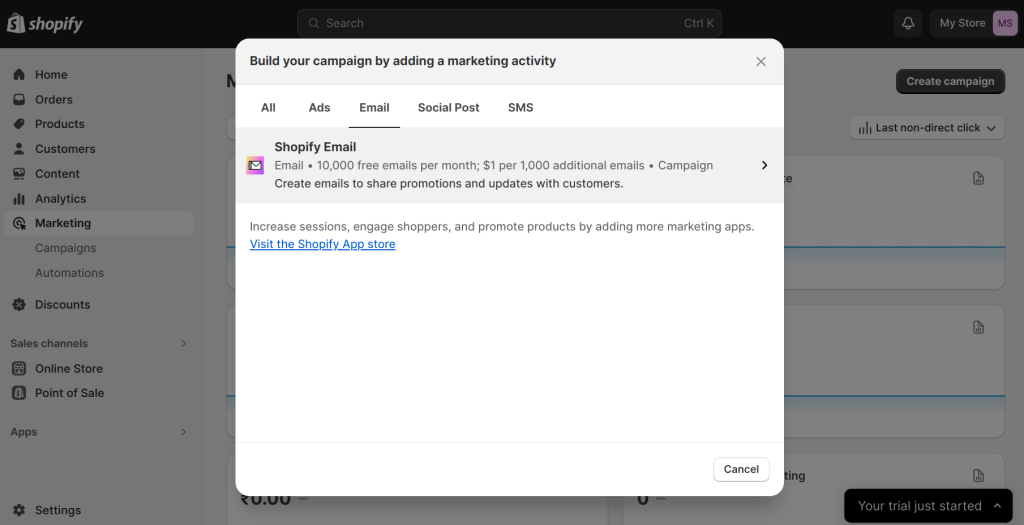
In Shopify Email, you have many email marketing templates to choose from – like newsletters, promotions, or product highlights. You also have the option to create your custom email templates.
Now, let’s choose the back-in-stock email template under the ‘Announcements’ section.
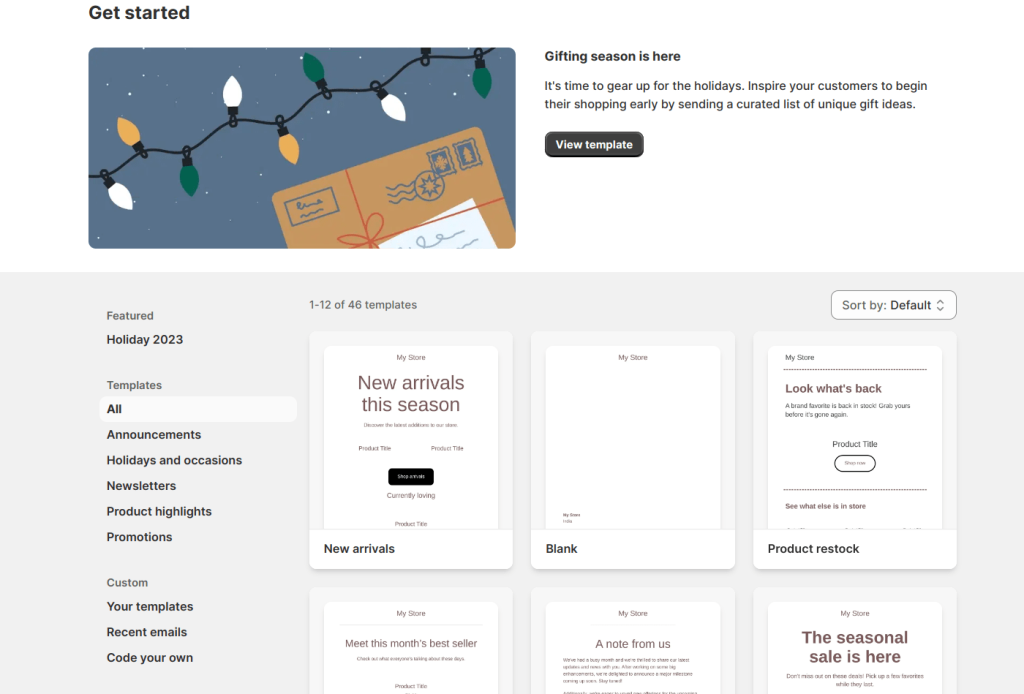
Step 5: Shopify email template customization
Before moving on to edit the content of the Shopify marketing email, you have to select which of your customers or segments should receive the email. Here, you can select the customer segments you have already created.
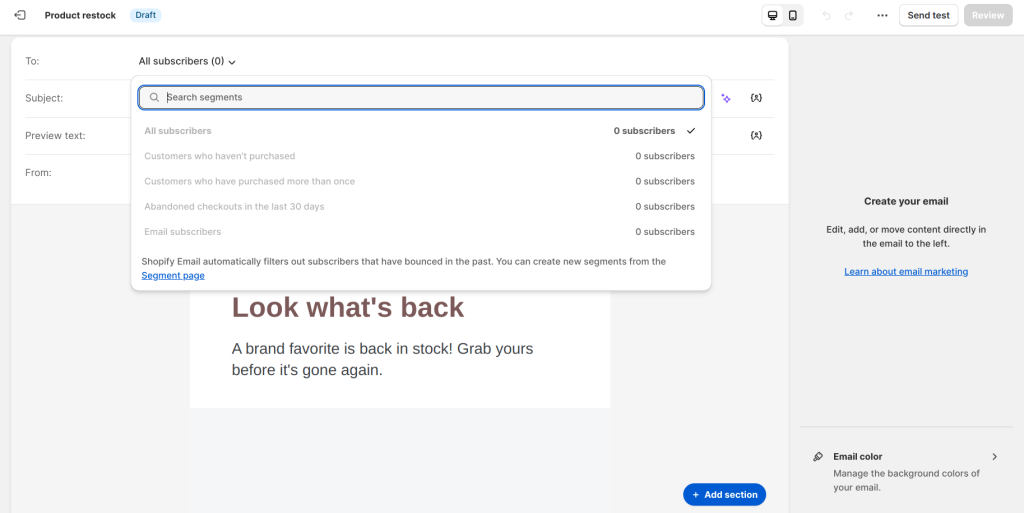
Then, you have to enter the subject lines, preview text, and the ‘from’ address.
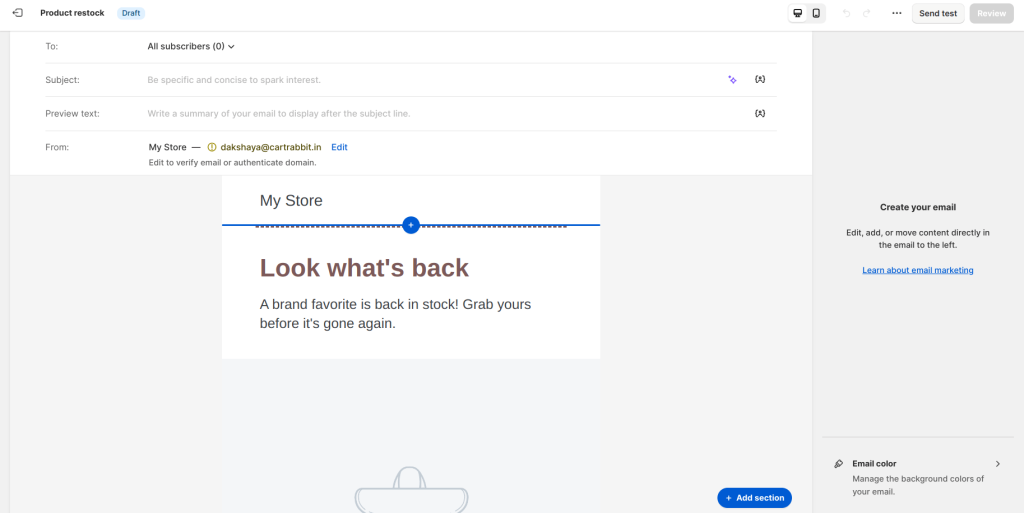
Now, we will get into the business of Shopify email template customization and its elements like logo, product images, footer, background color, and font style of those elements.
You have to select the element you want to edit, and a sidebar will appear where you can do all the customization of email templates.
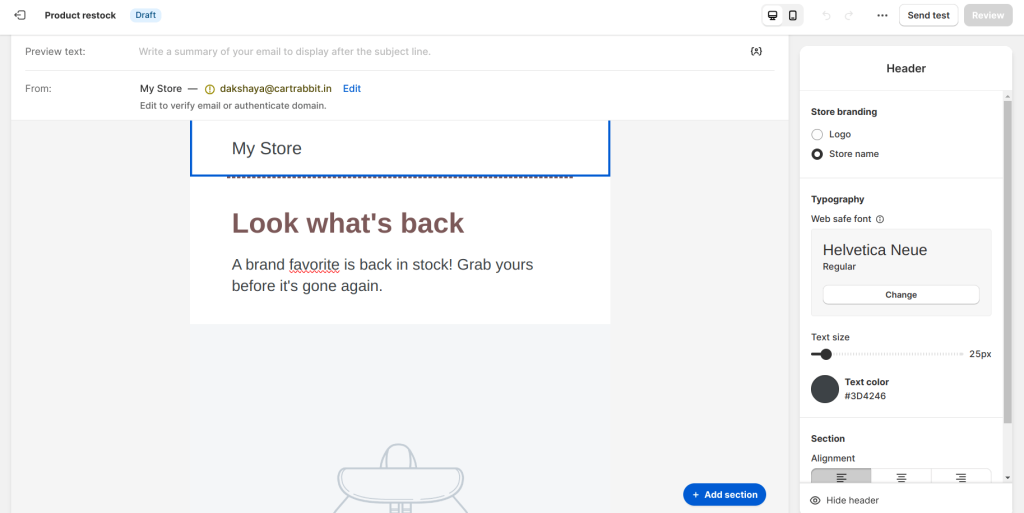
In this way, you can edit all the elements of your email and send customized email campaigns in Shopify.
Step 6: Test and launch Shopify email marketing campaign
Before sending the Shopify marketing emails, you have to test the email.
Enter your email address where you wish to receive the test email. If the email is looking as you intended, you can send your Shopify marketing emails.
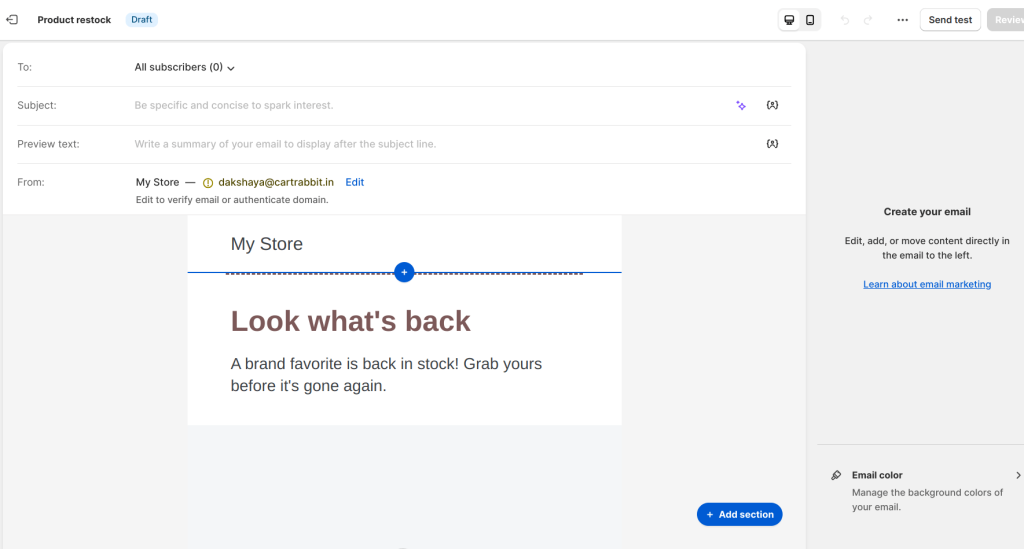
This is how to create email marketing on Shopify using its built-in feature. The scope for customizing and producing personalized emails is limited, and it is quite cumbersome to use, too.
Why choose a Shopify Email alternative?
Limitations of Shopify Email app are:
- Limited email automation capabilities
- Few ready-made email templates
- No advanced email segmentation
- Limited reporting and analytics
Shopify Email Marketing vs. Klaviyo
Here is a comparison between default Shopify email marketing and Klaviyo:
| Shopify Email | Klaviyo |
|---|---|
| Basic automation and segmentation | Multi-step automation sequences |
| Basic email template customization | Customize email template with dynamic content -insert product recommendations, dynamic coupon codes, personal product feed, etc., |
| Shopify Email pricing: 10,000 emails for free in Shopify paid subscription | $45 for 15,000 emails/month |
Verdict of Shopify Email vs. Klaviyo: If you’re just starting out, have a small list, or want quick, simple email campaigns right inside Shopify, Shopify Email is a great fit.
If you want to run complex segmentation like targeting VIP customers, predicting churn, and retargeting based on browsing behavior and multi-step email flows, choose Klaviyo.
Creating Personalized Shopify Email Marketing Campaigns using Retainful
Retainful is the best email marketing app for Shopify, tailor-made for e-commerce stores.
It has easy-to-setup email automation and pre-built workflows to create email marketing campaigns for Shopify in minutes. You can automate emails in 3 clicks, not 3 pages. It is the best alternative to Klaviyo for Shopify.
Here is a comparison of Retainful and Klaviyo Shopify email marketing apps.
| Retainful | Klaviyo |
|---|---|
| 57.8% more affordable than Klaviyo. Send 20,000 emails for just $19. | Sending 15,000 emails costs $45 |
| Easy-to-setup email automation | Complex visual automation builder with a steep learning curve. |
| Suitable for small and medium-sized e-commerce businesses | Suitable for only large businesses |
Related Reading: Know all about Klaviyo pricing hike and how it affects you here: Klaviyo Pricing 2025: What’s New and How It Affects You?
The steps for sending Shopify marketing emails in Retainful are:
- Install Retainful from the Shopify App Store.
- Sync orders and contacts of your Shopify store
- Create campaigns and set up email properties
- Edit email templates
- Select recipients by segmenting your email list
- Schedule and go live
Now, let’s move on to learn how to create an email marketing campaign on a Shopify email marketing app.
Let’s see the steps in detail.
Step 1: Install Retainful
To create Shopify email marketing, log in to your Retainful dashboard and go to ‘Campaigns’.
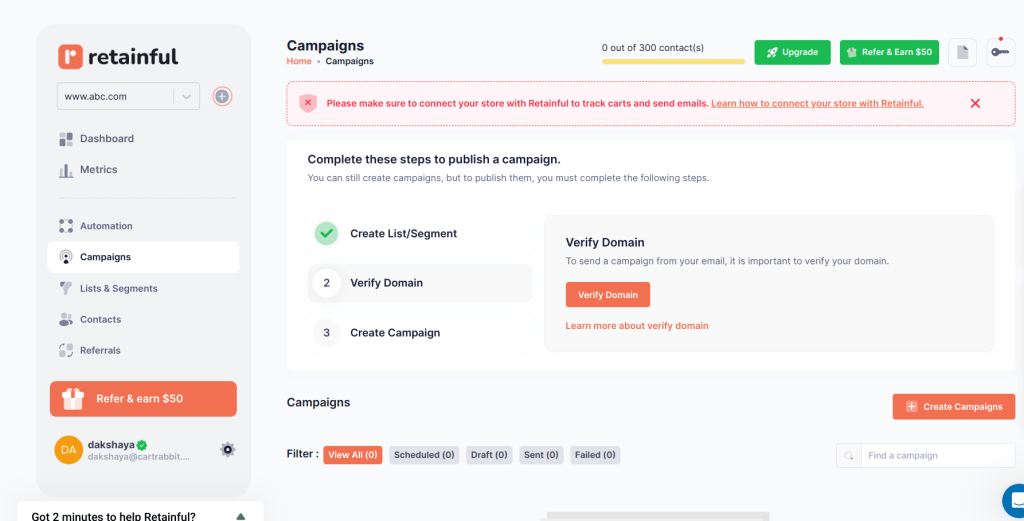
Step 2: Set up email properties
Write a subject line, preview text, and set up email properties like ‘from’ and ‘reply to’ email addresses.
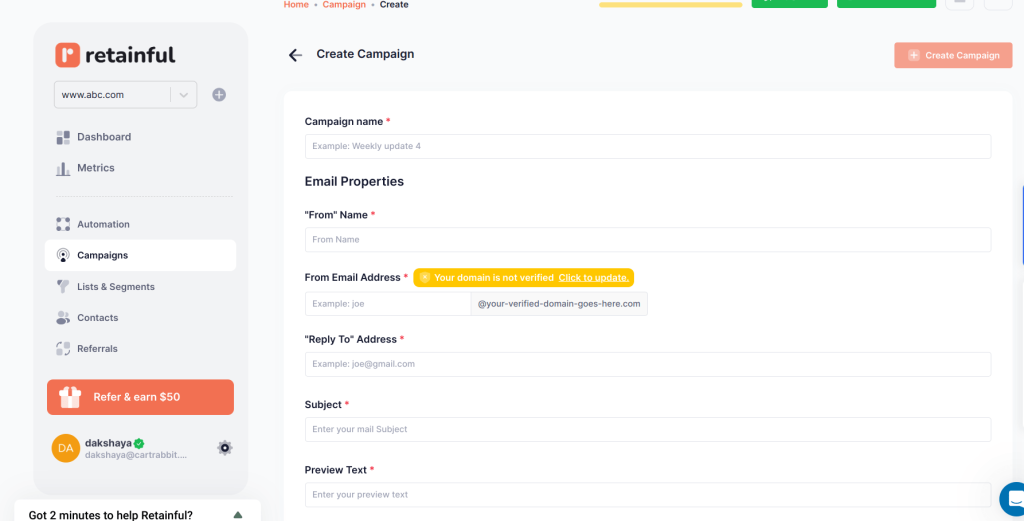
Step 3: Edit the email template
Retainful has a template library where you can choose your email template based on what type of email marketing campaign for Shopify you are planning to send.
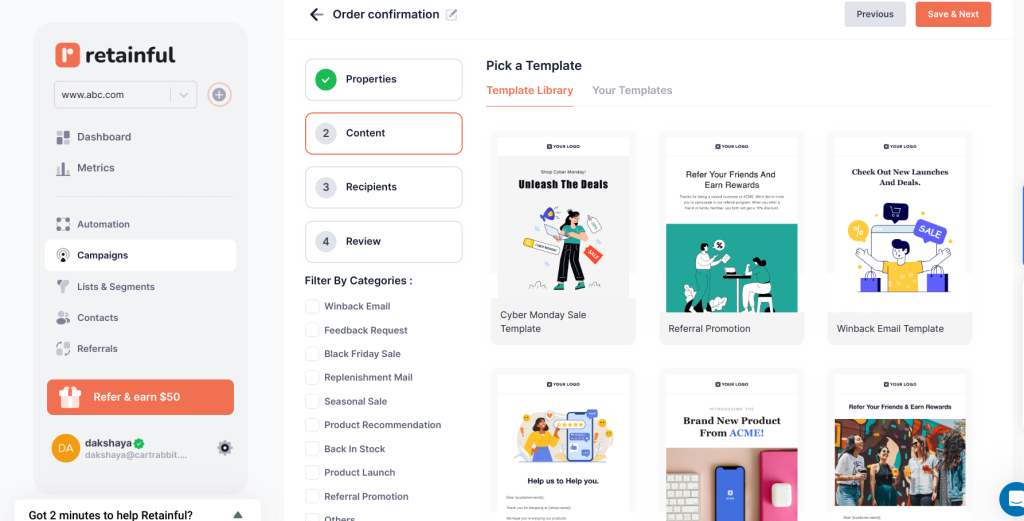
Let’s pick up the Back-in-stock email template.
Here is a peek into the drag-and-drop email template editor of Retainful, where you can customize every element of the template.
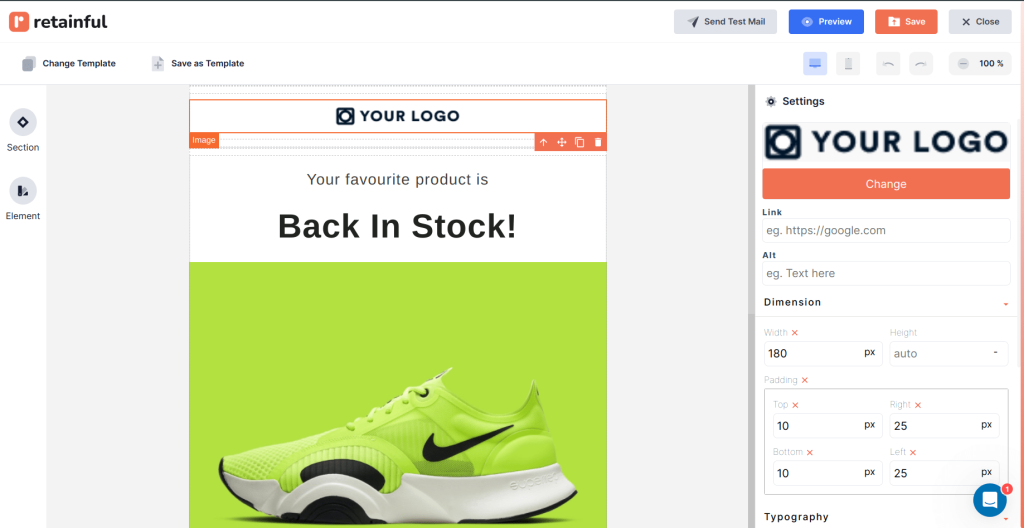
If you are done with your editing, send a test email to make sure the template has come out as you intended.
Step 4: Select recipients
Now the email is ready to go, you have to select the recipients – to all the contacts or only to contacts under a list or segment.
You can select the list or segment you have already created as your recipients.
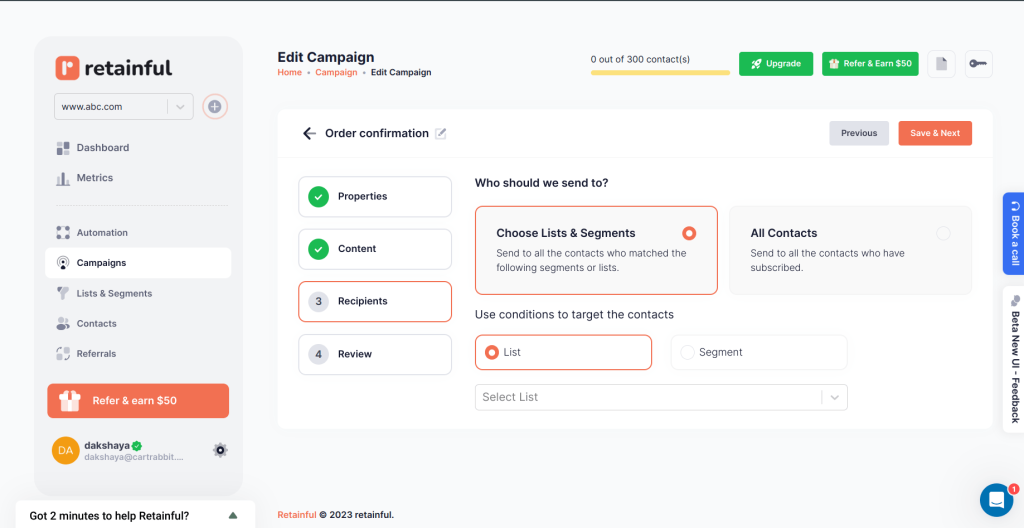
Step 5: Send the email marketing campaign
You can review the email properties, email templates, and recipients before clicking ‘Send’.
After reviewing the campaign, you need to click on the ‘Send Campaign’ button to send or schedule it.
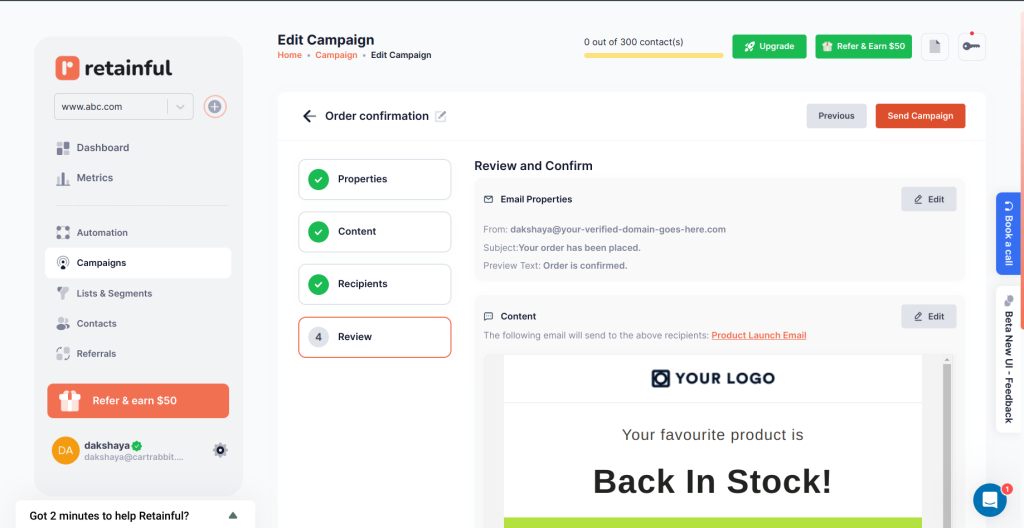
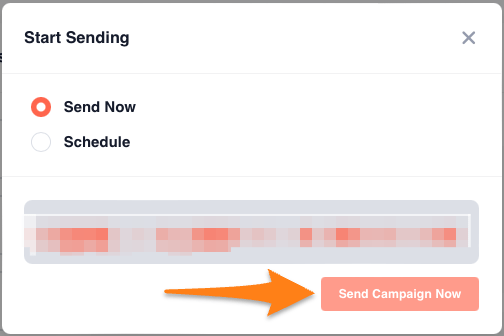
This is how to send marketing emails using email marketing software for Shopify. You can see that there is more scope for segmentation and customization than the built-in features of Shopify.
Best Email Marketing for Shopify – 5 Apps
The best Shopify email marketing apps are the ones that have seamless Shopify email marketing automation and allow you to personalize your emails.
The best Shopify email marketing apps are:
- Retainful
- Mailchimp
- Omnisend
- Constant Contact
- ActiveCampaign
Let’s analyze the best email marketing apps for Shopify in detail.
1. Retainful
Retainful is the best email marketing app for Shopify tailor-made for e-commerce businesses. It is an all-in-one platform to cover all your bases for email marketing in Shopify. Its pre-built workflows and templates will make it effortless to launch your email campaigns.
At its core lies a seamless email automation capability. With this automation feature, you can set up specific triggers – what triggers the email, entry rules – when a customer should enter the workflow, and customer rules – which customers should receive the email. This allows you to send customized Shopify email newsletter and trigger them based on a variety of customer actions.
To capture email addresses and grow an email list, you can create targeted sign-up forms that are tuned to visitor behavior and trigger at the right time to convert more.
It doesn’t stop there. This email marketing platform’s advanced segmentation feature allows you to group your customers based on many pre-defined or custom criteria and send personalized emails.

- Free plan – 500 emails/month
- $19/month – 20,000 email/month
- $49/month – 50,000 emails/month
2. Mailchimp
Mailchimp is a full-fledged digital marketing hub, giving you multichannel campaign support, website-building tools, reports, and Shopify automated email marketing.
This Shopify email marketing service boasts advanced automation and segmentation features like multiple triggers, predictive analytics, and more.
One of Mailchimp’s most outstanding features is that you can have a taste of almost all its key features with a free plan. You just have to sign up with your email to access the email marketing automation on Shopify, the marketing CRM, multichannel marketing tools, and pre-designed email templates.
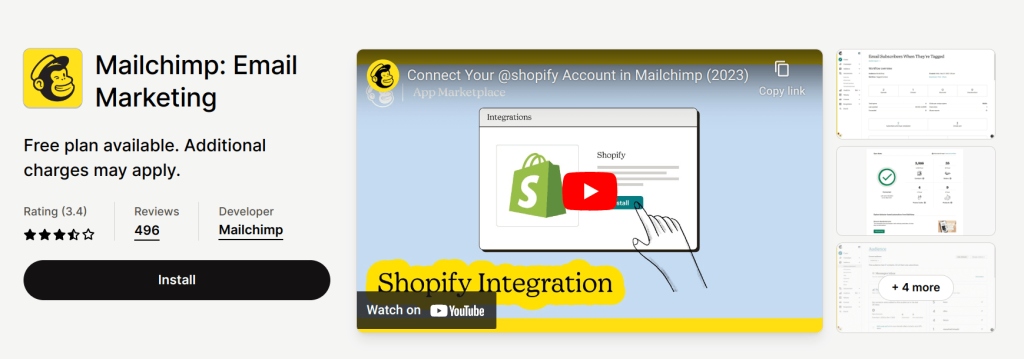
Price tiers and Email Volume:
- Free plan: 1000 Emails
- $4.60/month: 5000 Emails
- $6.87/month: 6000 Emails
- $137.41/month: 150,000 Emails
Related Reading: Explore Mailchimp Alternatives and their detailed comparison of features and pricing:
Shopify Email vs. Mailchimp – A Detailed Comparison
8 Best Mailchimp Alternatives and Competitors in 2025
3. Omnisend
Omnisend is an omnichannel marketing platform for Shopify that is tailored to e-commerce businesses. It provides email marketing automation capabilities, allowing you to set up automation workflows for creating Shopify promotional emails, cart abandonment emails, post-purchase, welcome emails, and more.
It allows you to include dynamic content in your Shopify automated emails using customer data and behavior, ensuring each recipient receives a tailored message.
This Shopify email marketing service offers an email template library, or you can create one on top of the pre-built layout. It also has a drag-and-drop email editor that allows you to create customized email campaigns in Shopify.
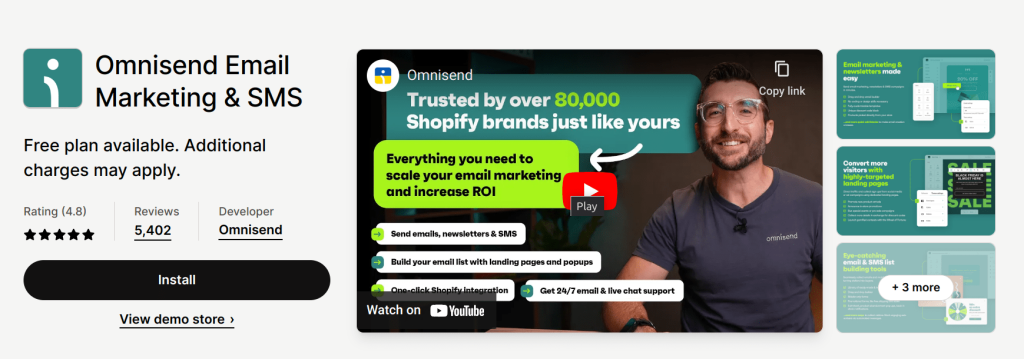
Price tiers and Email Volume:
- Free plan: 500 Emails
- $16/month: 6000 Emails
- $59/month: Unlimited Emails
4. Constant Contact
Constant Contact is a Shopify email marketing platform that offers user-friendly design tools, extensive templates, and advanced analytics, catering primarily to small and medium-sized businesses.
More than providing an email marketing tool to Shopify, Constant Contact features an event management tool. You can create, promote, manage registrations, and send follow-up emails for events all within the platform.
With this Shopify email marketing service, you can grow your email list in multiple ways, from website sign-up forms to integrations with social media platforms.
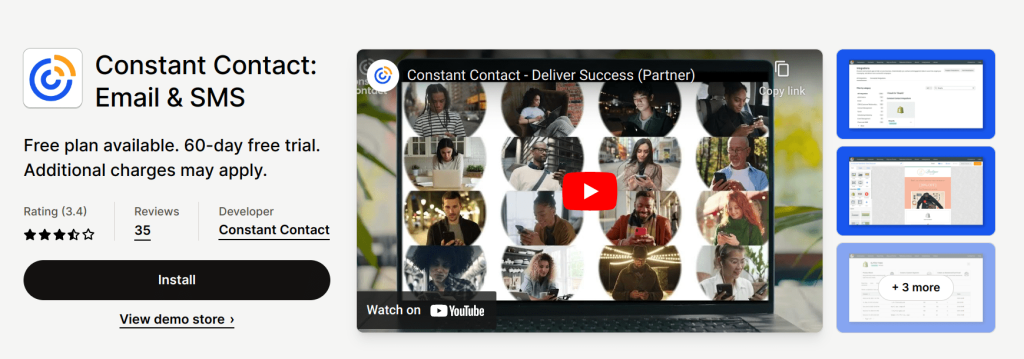
Price ties and Email Volume
- $12/month – 500 emails
- $55/month – 1000 emails
- $200/month – 5000 emails
5. ActiveCampaign
ActiveCampaign is an email marketing platform for Shopify that provides several functionalities tailored for e-commerce businesses.
It features advanced automation, which helps in crafting personalized customer journeys based on shopping behavior and interactions.
This email marketing software excels in its ability to track customer interactions on your store like pages visited, products viewed, and purchase history. Leveraging this data, the platform triggers event-based automation, sending highly targeted emails based on specific actions taken by customers.
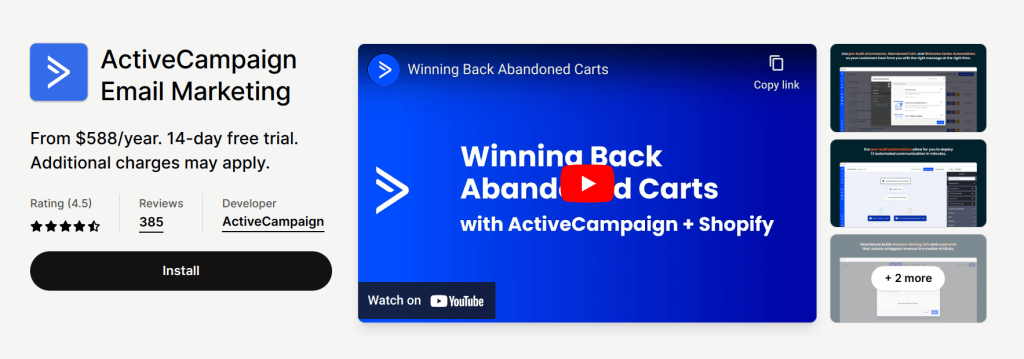
There you have it. The best email marketing apps for Shopify to create successful email campaigns.
Pricing tiers and email volume:
- A free plan is not available.
- $29/month – 1000 marketing contacts
- $49/month – 1000 marketing contacts + Facebook ads + Popups
Related Reading: Explore more email marketing software and their comparison with our blog:
10 Best Email Marketing Software Comparison and Review
8 Best Email Automation Software Comparison
Launch your email marketing campaigns in minutes with Retainful and witness your customer retention rate soar.
Get started with the Best Shopify Email Marketing
Shopify email marketing could be not just a step but a leap forward toward your revenue growth. It allows you to reach out to customers and engage them, sowing the seeds for successful conversions.
Throughout this guide, we’ve explored the intricacies of setting up effective Shopify email campaigns, how to do the best email marketing for Shopify using personalization and segmentation, and how to create email campaigns in Shopify and an email marketing app for Shopify.
Know more about Email marketing in Shopify:
- 10 Best Klaviyo Alternatives for E-commerce (+Comparison)
- How to add a Newsletter Popup in Shopify?
- 12 Most Important Email Marketing Metrics to Track
Frequently Asked Questions
Yes, Shopify has an in-built email marketing feature called ‘Shopify Email’ that allows you to create and send email marketing campaigns.
The best practices for Shopify email marketing are:
– Segment your customers
– Personalize email content
– Clean and update your email list
– Use automated workflows
– Maintain GDPR compliance
Shopify allows you to send up to 2,500 emails for free every month across all plans. Once you exceed this limit, additional emails are typically charged at a rate per 1,000 emails sent.
Email segmentation is critically important in Shopify email marketing for targeted communication and increased customer engagement. You get high conversion rates as a result of this.
To send marketing emails on Shopify:
1. Install and set up Shopify Email
2. Create and import email lists
3. Segment your customers
4. Choose the Shopify email marketing template
5. Customize the template
6. Test and launch the campaign
You can improve your email open rate and click-through rate in Shopify by:
1. Crafting compelling subject lines
2. Clear and concise CTAs
3. Segmenting your email list
4. Personalizing your email content
5. A/B testing
Email marketing is the most potent tool in recovering abandoned carts boasting high open rates and high recovery rates. On top of that, practices like automation, personalization, and timing increase your chances of effective abandoned cart recovery.
Yes, you can segment your email lists based on customer behavior in Shopify. Shopify’s platform provides robust data and analytics that can be utilized to segment your audience effectively based on their behavior.
Yes, you can send emails to all your customers in Shopify using its own marketing tool, “Shopify Email.”
Yes, you can customize email templates in Shopify. Shopify provides a range of customizable email templates that you can tailor to match your brand and messaging needs
Yes, Shopify can send automated emails. The platform provides various automation features that enable store owners to set up and send automated emails for different purposes. However, the scope for automation is very limited compared to what an email marketing app can offer.
Log into your Shopify admin dashboard. Go to the ‘Marketing’ section and then select ‘Campaigns’. Within the Campaigns section, you will find an option for creating automated email campaigns.

